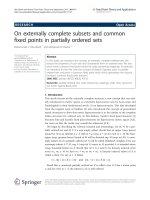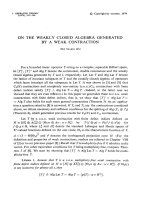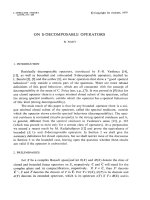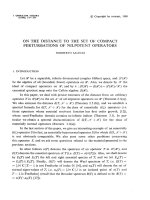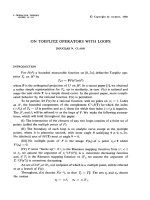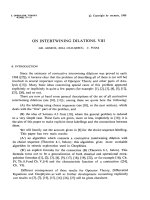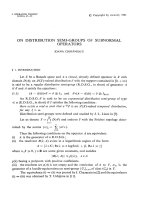Báo cáo toán học: "On edge colorings with at least q colors in every subset of p vertices" ppsx
Bạn đang xem bản rút gọn của tài liệu. Xem và tải ngay bản đầy đủ của tài liệu tại đây (107.12 KB, 6 trang )
On edge colorings with at least q colors in every subset
of p vertices
G´abor N. S´ark¨ozy, Stanley Selkow
Computer Science Department
Worcester Polytechnic Institute
Worcester, MA 01609
,
Submitted: April 26, 2000; Accepted: December 7,2000.
Abstract
For fixed integers p and q, an edge coloring of K
n
is called a (p, q)-coloring if
the edges of K
n
in every subset of p vertices are colored with at least q distinct
colors. Let f(n, p, q) be the smallest number of colors needed for a (p, q)-coloring
of K
n
. In [3] Erd˝os and Gy´arf´as studied this function if p and q are fixed and n
tends to infinity. They determined for every p the smallest q (=
p
2
− p +3) for
which f (n, p, q) is linear in n and the smallest q for which f (n, p, q) is quadratic in
n. They raised the question whether perhaps this is the only q value which results
in a linear f (n, p, q). In this paper we study the behavior of f(n, p, q) between the
linear and quadratic orders of magnitude. In particular we show that that we can
have at most log p values of q which give a linear f(n, p, q).
1 Introduction
1.1 Notations and definitions
For basic graph concepts see the monograph of Bollob´as [1]. V (G)andE(G)denotethe
vertex-set and the edge-set of the graph G. K
n
is the complete graph on n vertices. In
this paper log n denotes the base 2 logarithm. pr(n) denotes the parity of the natural
number n,soitis1ifn is odd and 0 otherwise.
1.2 Edge colorings with at least q colors in every subset of p
vertices
The following interesting concepts were created by Erd˝os, Elekes and F¨uredi (see [2]) and
then later studied by Erd˝os and Gy´arf´as in [3] (see also [4]). For fixed integers p and q
an edge coloring of K
n
is called a (p, q)-coloring if in every subset of p vertices at least q
the electronic journal of combinatorics 8 (2001), #R9 1
distinct colors appear on the edges. Let f(n, p, q) be the smallest number of colors needed
for a (p, q)-coloring of K
n
. It will be always assumed that p ≥ 3and2≤ q ≤
p
2
.We
restrict our attention to the case when p and q are fixed and n tends to infinity. The study
of f(n, p, q) leads to many interesting and difficult problems. For example determining
f(n, p, 2) is equivalent to determining classical Ramsey numbers for multicolorings.
Among many other interesting results and problems in [3] Erd˝os and Gy´arf´as deter-
mined for every p the smallest q (q
lin
=
p
2
− p + 3) for which f (n, p, q) is linear in n
and the smallest q (q
quad
=
p
2
−
p
2
+ 2) for which f (n, p, q) is quadratic in n.They
raised the striking question if q
lin
is the only q value which results in a linear f(n, p, q). In
this paper we study the behavior of f(n, p, q) between the linear and quadratic orders of
magnitude, so for q
lin
≤ q ≤ q
quad
. In particular we show that that we can have at most
log p values of q which give a linear f(n, p, q).
In order to state our results, first we need some definitions. We define the following
two strictly decreasing sequences a
i
and b
j
of positive integers with a
0
= p. Roughly
speaking a
i+1
=
a
i
2
but for every second odd a
i
we have to add 1.
The two sequences are defined recursively. Assuming a
0
,a
1
, ,a
i
are already defined,
the sequence b
1
,b
2
, , ,b
i
is just the subsequence consisting of the odd a
i
-s which are
greater than 1. Then we define
a
i+1
=
a
i
2
if a
i
= b
j
for an even j
a
i
2
otherwise
Furthermore if a
i+1
is odd and greater than 1, then b
i
+1
= a
i+1
.
So, for example, if p =2
k
, the sequence of a
i
-s is just all the powers of 2 from p to 1,
while there are no b
j
-s. Let l
p
be the smallest integer for which a
l
p
=1.
We will need the following simple lemma.
Lemma 1. For 1 ≤ i ≤ l
p
, we have
a
i
≤
p
2
i
+1−
1
2
i−1
<
p
2
i
+1. (1)
The simple inductive proof is given in the next section. This lemma immediately gives
the bound
l
p
≤log p. (2)
Our main result is the following.
Theorem 1. For positive integers p, 1 ≤ k ≤ l
p
,ifq ≥ q
lin
+ a
k
+ k − 1, then
f(n, p, q) >
1
4p
2
n
2
k
2
k
−1
.
Using Lemma 1, we immediately get the following.
the electronic journal of combinatorics 8 (2001), #R9 2
Corollary 2. For positive integers p, 1 ≤ k ≤ l
p
,ifq ≥ q
lin
+
p
2
k
+ k, then
f(n, p, q) >
1
4p
2
n
2
k
2
k
−1
.
Note that this is not far from the truth. (In fact, for k = 1 it gives the right order
of magnitude, namely quadratic.) Indeed, from the general probabilistic upper bound of
[3], we get the following.
Theorem 3. ([3]) For positive integers p, 1 ≤ k ≤ l
p
,ifq ≤ q
lin
+
p
2
k
−
1
2
k−1
, then
f(n, p, q) ≤ c
p,q
n
2
k
2
k
−1
,
where c
p,q
depends only on p and q.
Another corollary of the lower bound in Theorem 1 (k = l
p
and we use (2)) is that we
can have at most log p values with a linear f(n, p, q).
Corollary 4. If q ≥ q
lin
+logp, then
f(n, p, q) >
1
4p
2
n
2
l
p
2
l
p
−1
.
We have roughly a “gap” of size at most k in the values of q between the lower bound
of Corollary 2 and the upper bound of Theorem 3. It would be desirable to close this gap.
We believe, as is often the case, that the probabilistic upper bound (Theorem 3) is closer
to the truth. First we give some preliminary facts in the next section. Then in Section 3
we prove Theorem 1.
2 Preliminaries
Proof of Lemma 1: For the two sequences a
i
and b
j
defined earlier, we have
2a
i+1
= a
i
+
0ifa
i
= b
j
for any j (if a
i
is even)
1ifa
i
= b
j
for an even j
(−1) if a
i
= b
j
for an odd j
(3)
l
p
is the smallest integer for which a
l
p
= 1. To prove Lemma 1 we use induction on
i =1, 2, ,l
p
. It is true for i = 1. Assume that it is true for i andthenfori +1from
the definition of a
i+1
we get
a
i+1
≤
a
i
+1
2
≤
p
2
i
+1−
1
2
i−1
+1
2
=
p
2
i+1
+1−
1
2
i
,
and thus proving Lemma 1.
the electronic journal of combinatorics 8 (2001), #R9 3
Let l
p
be the number of b
j
-s among a
0
,a
1
, ,a
l
p
−1
. We introduce the following indi-
cator for 0 ≤ i ≤ l
p
− 1.
δ
i
=
1ifb
j−1
>a
i
≥ b
j
for an odd j>1, or if a
i
≥ b
1
, or for even l
p
if a
i
<b
l
p
0otherwise
We will need the following.
Lemma 2. For any 0 ≤ i ≤ l
p
− 1
i
j=0
a
l
p
−j
= a
l
p
−i−1
− δ
l
p
−i−1
− pr(l
p
). (4)
Proof: We use induction on i =0, 1, ,l
p
− 1. (4) is true for i =0,sincea
l
p
=1
and a
l
p
−1
=1+δ
l
p
−1
+ pr(l
p
).
Assuming that (4) is true for i,fori + 1 using (3) we get
i+1
j=0
a
l
p
−j
=
i
j=0
a
l
p
−j
+ a
l
p
−i−1
=2a
l
p
−i−1
− δ
l
p
−i−1
− pr(l
p
)=a
l
p
−i
− δ
l
p
−i
− pr(l
p
),
proving the lemma.
From this we get:
Lemma 3. For any 1 ≤ k ≤ l
p
k
j=1
a
j
≥ a
0
− a
k
− 1=p − a
k
− 1.
Proof:
k
j=1
a
j
=
l
p
−1
j=0
a
l
p
−j
−
l
p
−k−1
j=0
a
l
p
−j
= a
0
− δ
0
− a
k
+ δ
k
≥ a
0
− a
k
− 1.
3 Proof of Theorem 1
Let 1 ≤ k ≤ l
p
and q ≥ q
lin
+ a
k
+ k − 1. Denote
h = h(n, k)=
1
4p
2
n
2
k
2
k
−1
. (5)
Assume indirectly that there is a (p, q)-coloring of K
n
with at most h colors. From this
assumption we will get a contradiction.
Consider a fixed (p, q)-coloring of K
n
with at most h colors. We will find a sequence
of monochromatic matchings M
1
,M
2
, ,M
k
in K
n
. To obtain M
1
observe that there
the electronic journal of combinatorics 8 (2001), #R9 4
is a color class (denoted by C
1
)inK
n
which contains at least
(
n
2
)
h
edges. In C
1
all the
connected components have size at most p − 1, since otherwise we immediately have a K
p
with fewer than q colors, a contradiction. Then in C
1
we can clearly choose a matching
M
1
(for example by taking one edge from each non-trivial component) which is even and
has size at least
n
2
ph
.
Partition the vertices spanned by M
1
into A
1
and B
1
,soM
1
is a matching between A
1
and B
1
. Halve the vertices of A arbitrarily and denote one of the halves by A
1
. Denote
by B
1
the set of vertices in B
1
which are not matched to vertices in A
1
by M
1
. Consider
the complete bipartite graph between A
1
and B
1
and the color class (denoted by C
2
,not
necessarily distinct from C
1
) which contains the most edges in it.
Again from these edges in C
2
we can choose a matching M
2
with partite sets A
2
,B
2
of even size at least
|M
1
|
2
2
ph
.
We continue in this fashion. Assume that M
i
=(A
i
,B
i
) is already defined. Denote an
arbitrary half of the endvertices of M
i
in A
i
by A
i
. The set of endvertices of the edges of
M
i
in B
i
which are not matched to vertices in A
i
is denoted by B
i
. Consider the complete
bipartite graph between A
i
and B
i
and the color class (denoted by C
i+1
) which contains
the most edges in it.
From these edges in C
i+1
we can choose a matching M
i+1
of even size at least
|M
i
|
2
2
ph
.
Then by induction we have
|M
i
|≥
n
2
i
(4ph)
2
i
−1
.
Indeed, this is true for i =1
|M
1
| >
n
2
4ph
.
For i + 1 we get
|M
i+1
|≥
|M
i
|
2
2
ph
≥
n
2
i
2(4ph)
2
i
−1
2
ph
=
n
2
i+1
(4ph)
2
i+1
−1
.
This and (5) implies that |M
i
|≥p ≥ a
i
, 1 ≤ i ≤ k and thus the matchings M
1
,M
2
, ,M
k
can be chosen.
Next using these matchings M
i
we choose a K
p
such that it contains at most q − 1
colors, a contradiction. For this purpose we will find another sequence of matchings M
i
such that M
i
⊂ M
i
, |M
i
| = a
i
for 1 ≤ i ≤ k and
∪
k
i=1
V (M
i
)
≤ p.
the electronic journal of combinatorics 8 (2001), #R9 5
M
k
is just a set of a
k
arbitrary edges from M
k
. Assume that M
k
, ,M
i+1
are already
defined and now we define M
i
. We consider the 2a
i+1
vertices in V (M
i+1
) and the edges
of M
i
incident to these vertices. We have four cases.
Case 1: If 2a
i+1
= a
i
(so we have the first case in (3)), then this is M
i
.
Case 2: If 2a
i+1
= a
i
+1 (second case in (3)), so a
i
= b
j
for an even j,thenweremove
one of the edges from this set incident to a vertex in V (M
i+1
)∩A to get M
i
. Furthermore,
we mark this vertex in V (M
i+1
) ∩ A whichisnotcoveredbyM
i
. This marked vertex is
going to be covered only by M
i
if a
i
= b
j−1
(unless i
=0).
Case 3: If 2a
i+1
= a
i
− 1 (third case in (3)) and there is no marked vertex at the
moment, then to get M
i
we add one arbitrary edge of M
i
to these 2a
i+1
edges.
Case 4: Finally, if 2a
i+1
= a
i
− 1 and there is a marked vertex then to get M
i
we add
to these 2a
i+1
edges the edge of M
i
incident to the marked vertex and we “unmark” this
vertex.
We continue in this fashion until M
k
, ,M
1
are defined. Then
∪
k
i=1
V (M
i
)
= p or
p − 1. Note that it can be p − 1onlyifa
0
= p = b
1
is odd, and there is no other odd
a
i
among a
1
,a
2
, ,a
k−1
. In this case we add one more arbitrary vertex to get the K
p
,
otherwise ∪
k
i=1
V (M
i
)istheK
p
.
By the above construction this K
p
contains a
i
edges from the matching M
i
(and thus
from color class C
i
) for 1 ≤ i ≤ k.
Now since Lemma 3 implies
k
j=1
(a
j
− 1) ≥ p − a
k
− 1 − k,
thus the number of colors used in this K
p
is at most
p
2
− p + a
k
+ k +1≤ q − 1,
a contradiction. This completes the proof of Theorem 1.
References
[1] B. Bollob´as, Extremal Graph Theory, Academic Press, London (1978).
[2] P. Erd˝os, Solved and unsolved problems in combinatorics and combinatorial number
theory, Congressus Numerantium 32 (1981), 49-62.
[3] P. Erd˝os, A. Gy´arf´as, A variant of the classical Ramsey problem, Combinatorica 17
(4) (1997), 459-467.
[4] D. Mubayi, Edge-coloring cliques with three colors on all 4-cliques, Combinatorica
18 (2) (1998), 293-296.
the electronic journal of combinatorics 8 (2001), #R9 6

